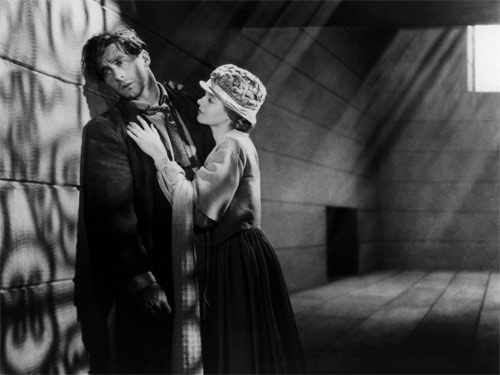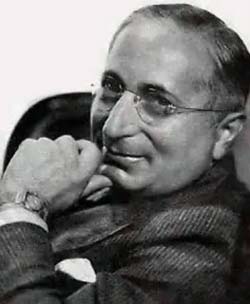
Cynics like me think of the Academy Awards less as a celebration of quality filmmaking than as a promotional tool, both for the nominated films, which coincidentally tend to come into the marketplace just at the time when "Awards Season" hype puts their titles on people's tongues, and for Hollywood as a whole. But it wasn't always so. Announced 80 years ago this week, the first-ever Academy Awards for the 1927-1928 business year were decided upon not by a large voting pool but a small cabal of judges in a smoke-filled room, handpicked by Academy of Motion Picture Arts and Sciences founder (and Metro-Goldwyn-Mayer studio chief) Louis B. Mayer. The surprising thing is that the winners really were some of the best cinematic achievements of the year.

Mayer had instigated the creation of the Academy as a means for staving off unionization efforts in Hollywood. As the story goes, his attempts to use MGM workers to construct his new Santa Monica beach house were foiled by a 1926 union contract which made studio laborers prohibitively expensive to employ for outside projects, even those strong-armed by the Big Boss. Mayer was outraged; he had been able to use MGM art director Cedric Gibbons to design his beach house because designers, as well as writers, directors, actors and producers, had not yet organized into guilds. By inviting prominent members of each profession into a fraternity (and it was mainly men at first; Mary Pickford was one of three women among the founding 36 members) known as A.M.P.A.S., Mayer staved off the further alphabet-souping of Hollywood talent into the S.A.G., D.G.A., W.G.A., etc. for several years.
Awards were an afterthought in the initial A.M.P.A.S. meetings, but they soon grew to become a crucial strategy of studio/employee relations. "I found that the best way to handle [moviemakers] was to hang medals all over them," Scott Eyman quotes Mayer in his biography of the mogul. "If I got them cups and awards they'd kill themselves to produce what I wanted. That's why the Academy Award was created." This quote might help explain why that first year, the statuettes (also designed by Gibbons) were often given out for a body of work, not for a contribution to a particular film. For example, Janet Gaynor won the first Actress award for her work in three films: 7th Heaven, Sunrise and Street Angel. German star Emil Jannings won the Actor statuette for two roles he played during his brief stint in Hollywood: The Last Command and The Way of All Flesh, which is the only Academy-Award winning performance in what is now considered to be a "lost film" — if you find it please inform the Academy Film Archive!

Other than a special non-competitive award given to the Warner Bros. studio for its breakthrough part-talkie The Jazz Singer, all of the first batch of films producing Academy Award wins were silent pictures, produced at the height of the form. Most are still considered great films today by those who have seen them: Josef von Sternberg's Underworld and The Last Command, Frank Borzage's 7th Heaven and Street Angel, F.W. Murnau's Sunrise, etc. One category was retired after the first ceremony because it was made obsolete by the popularity of sound. Joseph Farnham won the first and last statuette ever awarded for Title Writing. He'd composed the intertitles that represented dialogue and concisely smoothed transitions for more than a dozen MGM pictures that year, including films starring Lon Chaney, Norma Shearer, Ramon Novarro, and Joan Crawford. According to the Academy, no particular films were singled out from among his output for Farnham's award, but perhaps his best-remembered assignment is The Crowd, King Vidor's paean to the working man. Anyone who writes an intertitle as perfect as "When John was 21, he became one of the seven million that believes New York depends on them" seems like a worthy winner to me.
Farnham's statuette was the only one taken by an MGM employee that year. Given Louis B. Mayer's prominence in the creation of the Academy and its awards, he wanted to avoid the implications of impropriety which might have followed had his own studio been more successful in that inaugural year (though twelve months later at the second ceremony, nearly half the awards would go to MGM filmmakers). What's more, Mayer hated The Crowd, feeling it went against the glamorous image of the studio that boasted "more stars than there are in Heaven." The Crowd had none, but it did have supporters within the mogul's hand-picked Academy Award selection committee, and it took a long night of argument before he could convince them to pick Sunrise to receive the Unique and Artistic Picture award and relegate Vidor's film to runner-up status — there were no "nominees" back then. Of course, when the runner-up scroll was handed out at the Academy banquet three months later, Mayer was the one to accept it.
The Unique and Artistic Picture award that went to Sunrise went the same way as the Title Writing award. With the focus on promoting individual achievement rather than promoting films as a commodity for customers, there was no Best Picture category that first year. Though William Wellman's aviator picture Wings was retroactively honored in official Academy record books as the first Best Picture winner, the award it actually achieved was Production of Most Outstanding Picture, and it seems to have been awarded more for its epic scale than for its aesthetic quality; how else to explain how this very good film could be selected over a true masterpiece like 7th Heaven, which was a runner-up in the Production category even as its director and screenwriter won outright.
I often like to daydream about what kinds of films might be nominated if the Unique and Artistic category still existed at the modern-day Oscars. Might this year's category be filled with the likes of Wendy and Lucy, My Winnipeg, and Ballast? Maybe Wall-E could have found the home there that it couldn't in the Best Picture category this year? Of course if such an award were re-instated it would be an admission that the usual Best Picture slate is light on artistry even if it's heavy on impressive craftsmanship. And we all know that's not true. Unless maybe we're cynics.




Brian, thanks so much for letting us post this. This is really fantastic. When I think of all the movies that were made in '27, I do sometimes wonder whether the sound era came just a bit too early. What would those directors have made in '29 and '30?
Coincidentally, I'm doing my film history lecture in class today. 100 Years of Cinema in 55 minutes. Yeah, it's a bit ridiculous.
J. Robert, that sounds almost like a fun challenge! Ridiculous, definitely.
Your seemingly-rhetorical question about the great silent directors and what they'd have made in 1929 and 1930 is too interesting to pass up trying to answer, sticking to the five directors I mention in the article and what they actually produced during the silent/talkie transition period.
F.W. Murnau made City Girl in 1930, as a silent. Talking sequences were added by the studio after his completion of it, but only the silent version is known to exist today. A far lower overall budget compared to Sunrise doesn't prevent it from being a beautiful companion piece, contrasting city and country life in a very different way.
Josef Von Sternberg dove right into talkies in 1929 and 1930, with Thunderbolt, the Blue Angel and Morocco. The first of these is a bit rough around the edges, but extremely affecting, effective in its experimentations in sound (overlapping dialogue, for starters!), and creative in its approach to the reigned-in camera (the most pivotal scenes are set in constricting jail cells.) The latter two overcome any awkwardness Sternberg may have felt in regard to the transition to sound. They're classics, and innovative in their own right.
I haven't seen all of Frank Borzage's work from this period, for instance Lucky Star which is often acclaimed as a masterpiece (like City Girl it's a part-talkie with a now-lost soundtrack). I recently watched They Had to See Paris on DVD and found it charming if visually undistinguished for the most part. It was the first Will Rogers talkie, and he seems the more dominant creative force than Borzage in this picture.
Vidor, I'm even less familiar with, having only seen Hallelujah from this period, quite a while back at that. It struck me as successful in breaking out of the static pattern of most early-talkie camerawork. I believe Vidor found a way to record image and sound separately for that film, his first sound film.
William Wellman made talkies in those years but I haven't seen them. His 1928 Beggars of Life is a terrific film (again, I've seen only the silent version, not the part-talkie). By 1931 he was making pre-code scorchers like Night Nurse, Safe in Hell and the Public Enemy, where the dialogue is tough enough to make you forget that there's not much visual dynamism compared to that in a late silent.
Nice footnote, Brian.
I love that "middle period" of movies made right after the advent of talkies. Sound was new and novel enough that good filmmakers used it sparingly and creatively. Vigo's L'Atalante, Lang's M, and Dreyer's Vampyre come to mind.
Beggars of Life is great; I saw it at San Francisco's silent film fest and would love to see it again. That's the kind of movie I wish I would have taken family to see, since it's fun and exciting. I didn't realize there was a part-sound version.
Brian, isn't it true that while sound seems have arrived in the US instantly in 1929, it happened more gradually in Japan? Notable silent films were made in the early 1930s, including Ozu's I Was Born, But..., a personal fave.
The print of Borzage's "Lucky Star" that survives is the silent version as released in Europe and was not intended to be shown with sound. It took Europe longer to make the conversion to sound. Also, the silent version of Murnau's "City Girl" that we have is not the finished film that the director intended. He left William Fox before its completion and wrote extensive notes outlining the additonal material and changes he hoped would be done. The studio insteaded shot all kinds of additonal sound scenes that had nothing to do with Murnau's vision and cut much of film as it had be edited. Fortunately the Murnau unfinished version is the one that survives. Even in this unfinished form it is a work of great beauty. The Fox sound version was a major flop at the box office.
The Japanese film industry continued to make silent films for a number of years. They were shown with live narrators and music and this art form remained popular for sometime.
Yeah, the cost of installing sound technology in theatres made it spread more slowly through the rest of the world (not that it was exactly instantaneous in the US either, but that's a really complicated story). And in East Asia, where the tradition of the live performers providing narration and voicing dialogue to silents was strong, the process was extended even further. Japan didn't produce its first all-talkie feature until the Neighbor's Wife and Mine in 1931, and silent films were still being made by major filmmakers into the mid-1930s. Chinese silent cinema lasted at least as long. I know less about other countries' silent film traditions, but I have seen a Korean silent film made in 1948, screened with one of the last living byonsa performers in the theatre doing his narration. I don't know if silents were the norm at that late date or not. And Thailand may have had the longest-lasting silent era, as the industry was still distributing many of its films in 16mm silent prints until the early 1970s. Each town had a troupe of actors and musicians who would take care of the audio dimension of the film.